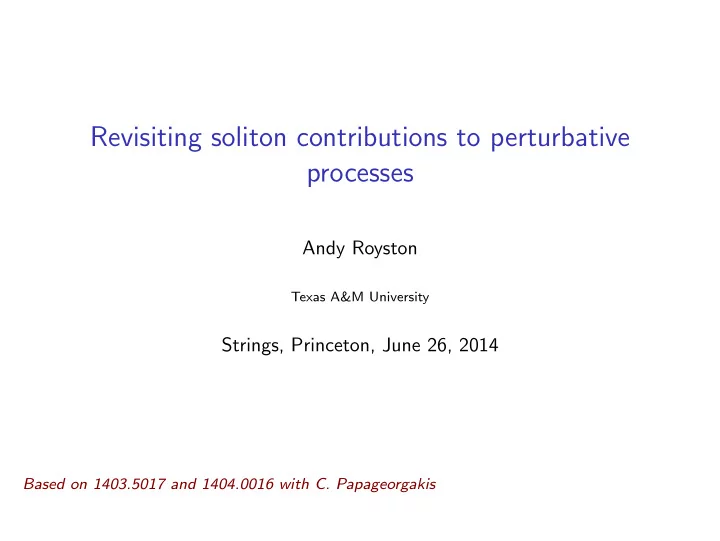

Revisiting soliton contributions to perturbative processes Andy Royston Texas A&M University Strings, Princeton, June 26, 2014 Based on 1403.5017 and 1404.0016 with C. Papageorgakis
Gong Show, Round 16 Even the “Fight of the Century” went only 15 rounds
Q & A Q: Do solitons run in loops? A: Yes, in the following sense: � � � � 2 f � d � f � � 2 Im f � � k � k k Q: • Can we compute their contribution to perturbative processes? • Is this contribution “exponentially suppressed”? (in what quantity?) 1 A: • Yes, under certain assumptions. • Usually, but not necessarily. (in the ratio R c / R S .) 1 Drukier and Nussinov (1982)..., Demidov and Levkov (2011), Banks (2012)
How do we compute? Use analyticity and crossing symmetry: S S S p 1 p 2 p 2 cross k t p 1 ' S k � A pair-prod ( k 2 ) A scat ( k 2 ) � = � � p ′ 1 = − p 1 compute A scat perturbatively in soliton sector: dtH I }| k , S ( p ′ 1 − p 2 ) A scat ( k 2 ) = � S ( p 2 ) | T { e − i � δ ( k + p ′ 1 ) �
Exhibiting suppression � � x − x 0 • consider class of scalar models φ ( x ) = φ S R S ; . . .
Exhibiting suppression � � x − x 0 • consider class of scalar models φ ( x ) = φ S R S ; . . . • find A pair − prod ( k 2 ) vanishes faster than any power in the ratio R c / R S for k 2 above † threshold (2 M S ) 2 † need to understand threshold effects better
Exhibiting suppression � � x − x 0 • consider class of scalar models φ ( x ) = φ S R S ; . . . • find A pair − prod ( k 2 ) “exponentially suppressed” in the ratio R c / R S for k 2 above † threshold (2 M S ) 2 A pair − prod ( k 2 ) � e − 2 R S / R c . . . † need to understand threshold effects better
Exhibiting suppression � � x − x 0 • consider class of scalar models φ ( x ) = φ S R S ; . . . • find A pair − prod ( k 2 ) “exponentially suppressed” in the ratio R c / R S for k 2 above † threshold (2 M S ) 2 A pair − prod ( k 2 ) � e − 2 R S / R c . . . • provided R S bounded away from zero (as a function on the moduli space of soliton solutions) † need to understand threshold effects better
Possible lessons for 5D MSYM • first take off the EFT glasses and suppose that 5D MSYM is a microscopic theory • ⇒ integrate over all loop momenta ( i.e. Λ UV → ∞ ) • but then, for k 2 > (2 M S ) 2 , will produce S - S pairs • R S = ρ → 0 so argument for exponential suppression breaks down, suggesting soliton contributions may compete • unfortunately approx. scheme also breaks down...need new methods
Possible lessons for 5D MSYM • first take off the EFT glasses and suppose that 5D MSYM is a microscopic theory • ⇒ integrate over all loop momenta ( i.e. Λ UV → ∞ ) • but then, for k 2 > (2 M S ) 2 , will produce S - S pairs • R S = ρ → 0 so argument for exponential suppression breaks down, suggesting soliton contributions may compete • unfortunately approx. scheme also breaks down...need new methods Thank you!
example with internal modulus 3 1 1 ( ∂µφ∂µφ + ∂µχ∂µχ ) − ( W 2 φ + W 2 L = χ ) 2 2 1 β χ 3 − χφ 2 − φ 3 W = χ − 3 3 � � � β 2 + 4 − β 2 + 4 + β b )2 + 4( b 2 − 1) βχ + b ( χ ⇒ φ ( χ ) = , 2 � � � � b 2 − 1 b 2 − 1( β 2 + 4 − β ) � 2 tanh( x − x 0) + 2 b β b � χ ( x ) = − − β 2 + 4 � � � b 2 − 1( β 2 + 4 − β ) 2 tanh( x − x 0) + 2 b b 2 − 1 Χ Φ 1.0 0.8 0.5 0.6 x � x 0 0.4 � 10 � 8 � 6 � 4 � 2 2 4 0.2 � 0.5 x � x 0 � 1.0 � 10 � 8 � 6 � 4 � 2 2 4 3 BNRT (1997); Brito and de Souza Dutra (2014)
Recommend
More recommend